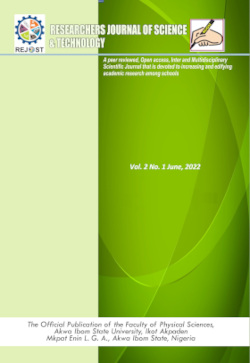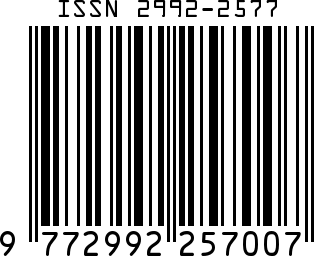Phase Transfer-Mediated Removal of Copper (II) and Zinc (II) Ions from Aqueous Solution
Keywords:
Phase transfer, Copper (II) ions, Zinc (II) ions, Palm kernel oil, Aqueous SolutionAbstract
Metal ions in aqueous solutions can be removed by phase transfer-mediation. The aim of this work was to use palm kernel oil (PKO) as an extractant in the presence of a chelating agent [ethylenediaminetetraacetic acid (EDTA)] for the removal of copper (II) and zinc (II) ions from an aqueous solution. The phase transfer of the metal ions was carried out by the addition of aqueous phases to different concentrations of organic phases using standard methods. The effect of the concentration of metal ions on the distribution coefficient and % removal efficiency was studied. The fatty acid composition of PKO was also determined. The results obtained revealed that the distribution coefficients and % removal efficiency of the metal ions increased with an increase in the initial concentrations of the copper (II) and zinc (II) ions. The zinc (II) ions were slightly increased after modification with EDTA. The concentrations of copper (II) and zinc (II) ions increased with an increase in the initial concentration of the aqueous phases and an increase in the volume of PKO, but showed a greater increase with the addition of EDTA. It was also observed that the most abundant fatty acid found in PKO was hexadecenoic acid (palmitic acid-C16:0). The results obtained revealed that PKO modified with EDTA can be an excellent organic solvent for the removal of metal ions from aqueous solutions.
References
Abdel Salam, O. E., Reiad, N. A., & ElShafei, M. M. (2011). A study of the removal characteristics of heavy metals from wastewater by low-cost adsorbents. Journal of Advanced Research, 2(4), 297-303. https://doi.org/https://doi.org/10.1016-/j.jare.2011.01.008
Al-Asheh, S., & Banat, F. (2001). Adsorption of copper and zinc by oil shale. Environmental Geology, 40(6), 693-698. https://doi.org/10.1007/s002540000234
Al-Othman, Z. A., Ali, R., & Naushad, M. (2012). Hexavalent chromium removal from aqueous medium by activated carbon prepared from peanut shell: Adsorption kinetics, equilibrium and thermodynamic studies. Chemical Engineering Journal, 184, 238-247. https://doi.org/https://doi.-org/10.1016/j.cej.2012.01.048
Ali, H., Khan, E., & Ilahi, I. (2019). Environmental Chemistry and Ecotoxi-cology of Hazardous Heavy Metals: Environmental Persistence, Toxicity, and Bioaccumulation. Journal of Chemistry, 2019, 6730305. https://doi.org/10.1155-/2019/6730305
Ali, R. M., Hamad, H. A., Hussein, M. M., & Malash, G. F. (2016). Potential of using green adsorbent of heavy metal removal from aqueous solutions: Adsorption kinetics, isotherm, thermodynamic, mechanism and economic analysis. Ecological Engineering, 91, 317-332. https://doi.org/https://doi.org/10.1016/j.ecoleng.2016.03.015
Amri, I. N. (2011). The Lauric (Coconut and Palm Kernel) Oils. In F. D. Gunstone (Ed.), Vegetable oils in food technology: Composition, properties and uses (pp. 169-197). https://doi.org/10.1002/9781444339925.ch6
Barakat, M. A. (2011). New trends in removing heavy metals from industrial wastewater. Arabian Journal of Chemistry, 4(4), 361-377. https://doi.org/https://doi.org/10.1016/j.arabjc.2010.07.019
Berger, K. G. (2003). Palm Kernel Oil. In B. Caballero (Ed.), Encyclopedia of Food Sciences and Nutrition (pp. 4322-4324). Academic Press. https://doi.org/10.1016/b0-12-227055-x/01379-1
Bhattacharya, A. (2019). Chapter 4 - Lipid Metabolism in Plants Under High Temperature. In A. Bhattacharya (Ed.), Effect of High Temperature on Crop Productivity and Metabolism of Macro Molecules (pp. 311-389). Academic Press. https://doi.org/https://doi.org/10.1016/B978-0-12-817562-0.00004-5
Blais, J. F., Dufresne, S., & Mercier, G. (1999). State of the art of technologies for metal removal from industrial effluents. Revue des Sciences de l'Eau, 12(4), 687-711.
Bunting, J. W., & Thong, K. M. (1970). Stability constants for some 1:1 metal–carboxylate complexes. Canadian Journal of Chemistry, 48(11), 1654-1656. https://doi.org/10.1139/v70-273
Camarillo, R., Llanos, J., García-Fernández, L., Pérez, Á., & Cañizares, P. (2010). Treatment of copper (II)-loaded aqueous nitrate solutions by polymer enhanced ultrafiltration and electrodeposition. Separation and Purification Technology, 70(3), 320-328. https://doi.org/https://-doi.org/10.1016/j.seppur.2009.10.014
Chang, J., Yoo, S., Lee, W., Kim, D., & Kang, T. (2017). Spontaneous Phase Transfer-Mediated Selective Removal of Heavy Metal Ions Using Biocompatible Oleic Acid. Scientific Reports, 7(1), 16727. https://doi.org/10.1038/s41598-017-17092-9
Chi, Q.-q., Zhu, G.-w., & Langdon, A. (2007). Bioaccumulation of heavy metals in fishes from Taihu Lake, China. Journal of Environmental Sciences, 19(12), 1500-1504. https://doi.org/https://doi.org/10.1016/S1001-0742(07)60244-7
Dabrowski, A., Hubicki, Z., Podkościelny, P., & Robens, E. (2004). Selective removal of the heavy metal ions from waters and industrial wastewaters by ion-exchange method. Chemosphere, 56(2), 91-106. https://doi.org/10.1016/j.chemosphere.2004.03.006
Diezel, W., Schulz, E., Shanks, M., & Heise, H. (1993). Plants oils: Topical application and anti-inflammatory effects (Croton oil test). Dermatologische Monatsschrift, 179, 173-173.
Edem, D. O. (2002). Palm oil: biochemical, physiological, nutritional, hematological, and toxicological aspects: a review. Plant Foods for Human Nutrition, 57(3-4), 319-341. https://doi.org/10.1023/a:102182-8132707
Faur-Brasquet, C., Kadirvelu, K., & Le Cloirec, P. (2002). Removal of metal ions from aqueous solution by adsorption onto activated carbon cloths: adsorption competition with organic matter. Carbon, 40(13), 2387-2392. https://doi.org/https://-doi.org/10.1016/S0008-6223(02)00117-3
Fu, F., Chen, R., & Xiong, Y. (2006). Application of a novel strategy—Coordination polymerization precipitation to the treatment of Cu2+-containing wastewaters. Separation and Purification Technology, 52(2), 388-393. https://doi.-org/https://doi.org/10.1016/j.seppur.2006.05.017
Fu, F., & Wang, Q. (2011). Removal of heavy metal ions from wastewaters: A review. Journal of Environmental Management, 92(3), 407-418. https://doi.org/https:-//doi.org/10.1016/j.jenvman.2010.11.011
Ghanadzadeh, H., & Abbasnejad, S. (2011). Separation of copper (II) with solvent extraction using lauric acid diluted in benzene. J. Thermodyn. Catal, 2(2), 1-6.
Gibon, V. (2012). 12 - Palm Oil and Palm Kernel Oil Refining and Fractionation Technology. In O.-M. Lai, C.-P. Tan, & C. C. Akoh (Eds.), Palm Oil (pp. 329-375). AOCS Press. https://doi.org/https://doi.-org/10.1016/B978-0-9818936-9-3.50015-0
Gold, I. L., Ikuenobe, C. E., Asemota, O., & Okiy, D. A. (2012). 10 - Palm and Palm Kernel Oil Production and Processing in Nigeria. In O.-M. Lai, C.-P. Tan, & C. C. Akoh (Eds.), Palm Oil (pp. 275-298). AOCS Press. https://doi.org/https://doi.-org/10.1016/B978-0-9818936-9-3.50013-7
Gunstone, F. (2011). Vegetable Oils in Food Technology: Composition, Properties and Uses. Wiley.
Habibiasr, M., Mokhtar, M. N., Ibrahim, M. N., Yunos, K. F. M., & Ibrahim, N. A. (2022). Effect of drying on the physical and chemical properties of palm kernel oil. Journal of the science of food and agriculture, 102(10), 4046-4053. https://-doi.org/10.1002/jsfa.11753
Halim, S. F. A., Chang, S. H., & Ahmad, S. K. N. (2019). Extraction of copper ions from aqueous solutions with oleic acid as green solvent. Journal of Physics: Conference Series, 1349(1), 012128. https://doi.org-/10.1088/17426596/1349/1/012128
Heikens, A., Peijnenburg, W. J. G. M., & Hendriks, A. J. (2001). Bioaccumulation of heavy metals in terrestrial invertebrates. Environmental Pollution, 113(3), 385-393. https://doi.org/https://doi.org/10.1016/S0269-7491(00)00179-2
Hu, B., Chen, B., He, M., Nan, K., Xu, Y., & Xu, C. (2019). Chapter Four - Separation methods applied to arsenic speciation. In A. C. Duarte & V. Reis (Eds.), Comprehensive Analytical Chemistry (Vol. 85, pp. 89-144). Elsevier. https://doi.org-/https://doi.org/10.1016/bs.coac.2019.04.001
Jaishankar, M., Tseten, T., Anbalagan, N., Mathew, B. B., & Beeregowda, K. N. (2014). Toxicity, mechanism and health effects of some heavy metals. Interdiscip Toxicol, 7(2), 60-72. https://doi.org-/10.2478/intox-2014-0009
Jalani, B. S., Kushairi, A., & Cheah, S. C. (2003). PRODUCTION SYSTEMS AND AGRONOMY | Oil Palm and Coconut. In B. Thomas (Ed.), Encyclopedia of Applied Plant Sciences (pp. 960-969). Elsevier. https://doi.org/https://doi.org/10.1016/B0-12-227050-9/00206-4
Kalhapure, R. S., & Akamanchi, K. G. (2013). A novel biocompatible bicephalous dianionic surfactant from oleic acid for solid lipid nanoparticles. Colloids and Surfaces B: Biointerfaces, 105, 215-222. https://doi.-org/https://doi.org/10.1016/j.colsurfb.2013.01.011
Khan, A. A., & Mondal, M. (2021). Low-cost adsorbents, removal techniques, and heavy metal removal efficiency. In M. P. Shah, S. Rodriguez Couto, & V. Kumar (Eds.), New Trends in Removal of Heavy Metals from Industrial Wastewater (pp. 83-103). Elsevier. https://doi.org/https://doi.org/10-.1016/B978-0-12-822965-1.00004-0
Li, C. J., & Trost, B. M. (2008). Green chemistry for chemical synthesis. Proceedings of the National Academy of Sciences of the United States of America, 105(36), 13197-13202. https://doi.org/10.1073/pnas.080-4348105
Mancini, A., Imperlini, E., Nigro, E., Montagnese, C., Daniele, A., Orrù, S., & Buono, P. (2015). Biological and Nutritional Properties of Palm Oil and Palmitic Acid: Effects on Health. Molecules, 20(9), 17339-17361. https://-www.mdpi.com/1420-3049/20/9/17339
Matlock, M. M., Howerton, B. S., & Atwood, D. A. (2002). Chemical Precipitation of Lead from Lead Battery Recycling Plant Wastewater. Industrial & Engineering Chemistry Research, 41(6), 1579-1582. https://doi.org/10.1021/ie010800y
May, C. Y., & Nesaretnam, K. (2014). Research advancements in palm oil nutrition. European Journal of Lipid Science and Technology, 116(10), 1301-1315. https://doi.org/10.1002/ejlt.201400076
Nainggolan, M., & Sinaga, A. G. S. (2021). Characteristics of fatty acid composition and minor constituents of red palm olein and palm kernel oil combination. J Adv Pharm Technol Res, 12(1), 22-26. https://doi.org/10.4103/japtr.JAPTR_91_20
Nordberg, M., & Nordberg, G. F. (2009). Toxicology and Biological Monitoring of Metals. In General, Applied and Systems Toxicology. https://doi.org/https://doi.org-/10.1002/9780470744307.gat145
Pacheco-Fernández, I., & Pino, V. (2019). Green solvents in analytical chemistry. Current Opinion in Green and Sustainable Chemistry, 18, 42-50. https://doi.org/https-://doi.org/10.1016/j.cogsc.2018.12.010
Pantzaris, T., & Basiron, Y. (2002). The lauric (coconut and palm kernel) oils. In F. D. Gunstone (Ed.), Vegetable oils in food technology: Composition, properties and uses (pp. 157). Blackwell Publishing.
Papandreou, A., Stournaras, C. J., & Panias, D. (2007). Copper and cadmium adsorption on pellets made from fired coal fly ash. Journal of Hazardous Materials, 148(3), 538-547. https://doi.org/https://doi.org/10-.1016/j.jhazmat.2007.03.020
Poku, K. (2002). Small-scale palm oil processing in Africa. Food & Agriculture Org.
Reza, R., & Singh, G. (2010). Heavy metal contamination and its indexing approach for river water. International Journal of Environmental Science & Technology, 7(4), 785-792. https://doi.org/10.10-07/BF03326187
Singh, S. K., & Savoy, A. W. (2020). Ionic liquids synthesis and applications: An overview. Journal of Molecular Liquids, 297, 112038. https://doi.org/https://-doi.org/10.1016/j.molliq.2019.112038
Tian, M., Fang, L., Yan, X., Xiao, W., & Row, K. H. (2019). Determination of Heavy Metal Ions and Organic Pollutants in Water Samples Using Ionic Liquids and Ionic Liquid-Modified Sorbents. Journal of Analytical Methods in Chemistry, 2019, 1948965. https://doi.org/10.1155/2019-/1948965
Yeong, S. K., Idris, Z., & Hassan, H. A. (2012). 20 - Palm Oleochemicals in Non-food Applications. In O.-M. Lai, C.-P. Tan, & C. C. Akoh (Eds.), Palm Oil (pp. 587-624). AOCS Press. https://doi.org/https://doi.org-/10.1016/B978-0-9818936-9-3.50023-X

Downloads
Published
How to Cite
Issue
Section
License
Copyright (c) 2023 Researchers Journal of Science and Technology

This work is licensed under a Creative Commons Attribution-NonCommercial-NoDerivatives 4.0 International License.




